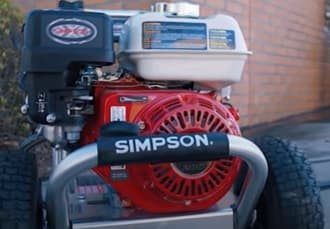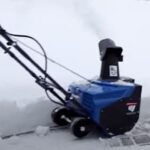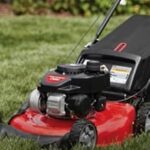As an Amazon Associate, this site earns commissions from qualifying purchases. For more information click here.
Is your pressure washer pulsing up and down? This can happen suddenly and make it impossible to get any washing done. While this can be disconcerting, it is possible to fix the problem without seeking professional help. This post explains what you should do when surging occurs.
Pressure washers surge during idle because its filters are blocked, the carburetor is clogged or there is a defective spark plug. Any of these problems will prevent the engine from running correctly. Cleaning or replacing the clogged parts is the best solution.
Dirty Air Filter
In looking for solutions we should start with the simplest and most likely. In this case that is the air filter. Just like with other small engines, the air filter in pressure washers have to be cleaned regularly. When the filter gets clogged with material the engine no longer functions normally, causing it to pulse and surge.
Air filters should be cleaned at least every 12 months. If the filter is too dirty, replace it. Remove the filter and examine it for signs of damage. If there is none, give it a thorough cleanup then try the pressure washer again. The Sun Joe SPX3000 will definitely run better if you do this.
Air filters are made of either foam or paper. Paper air filters are not reusable and have to be replaced. Foam filters can be cleaned and reused. After cleaning, wait for the filter to dry. Put in some engine oil and the pressure washer should be ready to go.

Dirty Fuel Filter and Fuel Cap
Fuel filters get dirty due to debris and old gas. A clogged fuel filter affects the way the engine runs. Remove the fuel filter and eliminate all traces of old fuel residue in the engine. If you have a Simpson MSH3125 for example, this type of maintenance is essential.
Make certain the fuel cap is not blocked. The cap has holes that allow to pass and be mixed with the fuel. If the fuel cap is clogged, air will not be able to reach the engine. If this happens, the fuel mix becomes too rich (due to lack of air) or the engine does not run at all.
Once you have cleaned the fuel cap, install a new fuel filter. Turn the engine on and observe if it still surges. If the fuel filter or cap was the issue, it should be running fine now.
Fix the Unloader Valve
The unloaded valve is the component that delivers pressurized water after you squeeze the trigger. The spring in the unloader valve is responsible for the increase and decrease in water pressure when you handle the trigger. Adjusting the valve can fix the surging and idling problem.
- Use a screwdriver to remove the screws on the pressure washer pump case.
- Lift the case and you will see the pump. Below it is the outlet unloader valve and a spring loaded plunger.
- Take off the top and after securing the nuts, adjust the spring. After tightening, engage the trigger so the unloader valve does not get blocked.
- Adjust the knob until you get to the point where surges are at the lowest and the pressure highest. The spike must be under 10%. Adjust the knob slowly and observe the changes.
Fixing and adjusting the unloader valve can be challenging. Your owner’s manual should have information on its exact location in the engine.
Defective Spark Plug
Small engines may surge at idle due to a faulty spark plug. Check for any loose connections and secure them. Next, inspect the spark plug itself. Are the ends corroded? Wipe it clean and put it back on.
If the pressure washer still won’t run, use a spark plug tester to check if it is still working. Get a new one if the plug is defective. If the spark plug looks burnt or completely covered in carbon deposit, a replacement is recommended.
Spark plugs for pressure washers are widely available so finding one is not an issue. But make certain it is designed for the specific pressure washer you are using.
These solutions will work with almost all pressure washers including those with Honda engines. If you have trouble getting your Honda pressure washer to start, this guide can help.
Blocked Carburetor
A clogged carburetor leads to all sorts of problems because it provides the fuel and air mixture. Dirt, debris and old fuel can clog the system and prevent it from running properly.
Once the carburetor is cleaned, regular maintenance is necessary. If you are going to store the pressure washer for winter, drain the fuel tank or add a fuel stabilizer.
The following steps explain how to clean a pressure washer carburetor. If cleaning does not work, you might have to replace the carburetor.
- Turn the pressure washer off. Allow the engine to cool first.
- Remove the casing cover. Depending on your pressure washer, it might be necessary to remove other parts to access the carburetor.
- Disconnect the fuel lines. Check the line for damage and replace it. If the fuel is more than 60 days old, replace it.
- Drain the fuel. Clean the area if it is covered in old gas sludge then drain whatever is left of the fuel. When you open the tank the fuel might suddenly gush out, so have a pan or container ready underneath it.
- Take out the carburetor carefully. You might have to remove some pieces to thoroughly clean it. Arrange the pieces you remove in order so you can put everything back together.
Use a cleaning solution to remove the dirt and debris. Once the carburetor is cleaned, put all the pieces back. Put the carburetor back. Add fuel and turn on the pressure washer again.
Check the Water Source
Pressure washers need at least 1.5 GPM to run. If the water supply is insufficient, little to no water will come out of the nozzle.
Check the water supply pressure. If it is less than 1.5 GPM the pressure must be increased. Some pressure washers can handle lower GPM but others cannot. Check your owner’s manual for details on the GPM.
Pressure washers also need at least 2000 PSI. Some models may run on 1500 but if you are not sure, consult the manual.
Pressure washer hose problems. Issues with the hose can result in surging. Most pressure washers prefer a diameter of 0.75 inches and using another size could result in puling or surging.
Use the shortest hose possible and minimize the twists and curls. A short, straight hose provides the highest pressure. The longer the hose the more time it takes for water to reach the nozzle. If the hose is twisted or has kinks, it reduces pressure or can impede water flow.
Spray nozzle. A blocked nozzle is one of the possible reasons for surging. Clean or replace the nozzle and try again. Some nozzles have multiple settings and picking the wrong one can cause surging or drops in pressure.
Wrong Fuel Mixture
This happens with poorly maintained pressure washers. There has to be a specific amount of air and fuel in it. If the carburetor or filters are dirty or clogged with old fuel, there is only a limited amount of air that can go through it.
This occurs when fuel is left in the tank for more than two months. You should always replace the fuel every eight weeks or put a fuel stabilizer. Because of how it works, the gas will be preserved well. If you do not, the gas evaporates and leaves behind a gummy substance. It is this substance and accumulated dirt that messes up the fuel mixture.
Carburetor Adjustment
You can also fix idling and surging problems by adjusting the carburetor screws. If you look at the carburetor you will see three screws, L (low speed), H (high speed) and idle.
Use a screwdriver to rotate the screws. Doing so change the idling speed and RPMs. Because each turn produces significant changes, be very careful when adjusting the screws. Use this only if the other things you have tried such as cleaning the carburetor and filters do not work.

I love the outdoors and all the tools for maintaining gardens, yards and lawns. The only thing I am more passionate about is sharing what I know about garden and outdoor equipment.


